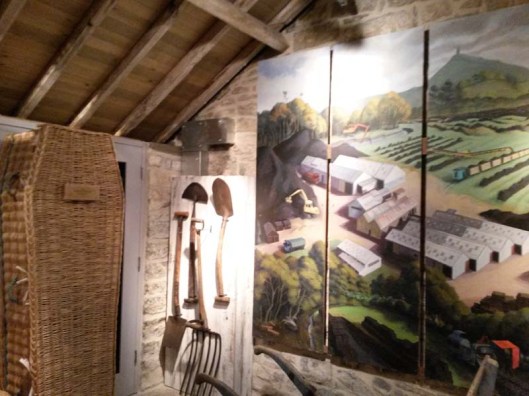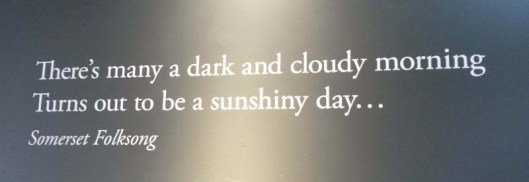Tags
Glastonbury Abbey, Glastonbury Tor, Harriet Mead, Hitler, James Lynch, Mapstone, Mussolini, Somerset Rural Life Museum, South West Heritage Trust
I live just a five-minute walk from the Somerset Rural Life Museum, which has been closed for refurbishment for the last three years. Its unofficial official reopening was yesterday, and a friend, Liz, and I went to it. What a fantastic job they’ve done! The Museum comprises a farmhouse, the Abbey Barn (that’s Glastonbury Abbey) and a small amount of land. Until Henry VIII’s 16th century Dissolution of all the abbeys, all the land round here belonged to the Abbey. Since then it has passed through many hands, and in 1917 George Mapstone took over the tenancy. Mr and Mrs H R Mapstone bought the farm in 1940. Mrs Mapstone sold most of the land for housing (including where I live) in 1974, but gave the farmhouse and the Abbey Barn to Somerset County Council which used it for the museum. (For the history of the landholding – and much more about Glastonbury – see here.)
The unofficial official opening took place on the north side of the Barn. Because it was an unofficial official opening there was no ribbon to be cut (the official official opening will be by the Duke of Gloucester in a week or so’s time), so instead the last surviving Mapstone daughter and the Chairman of the Trustees of the museum together unveiled the flag of Somerset. Given the numbers present, we were invited not all to go in via the front door (of the farmhouse), so Liz and I made straight for the courtyard,
Given the numbers present, we were invited not all to go in via the front door (of the farmhouse), so Liz and I made straight for the courtyard,

(Glastonbury Tor in the background)
where there was music, but most importantly the horse, Captain, made entirely of scrap metal.
but most importantly the horse, Captain, made entirely of scrap metal.  Liz’s partner, Ray, had been in charge of the machinery which had lifted him into place, and had apparently come home that day raving about the sculpture. Liz and Ray know a thing or two professionally about horses, and Liz was exclaiming how completely anatomically correct this creation was. Moreover, she had learned that the sculptor, Harriet Mead, had made no preliminary drawing, but had just started welding pieces of scrap metal together. (Her work has been featured on the BBC’s ‘Countryfile’.)
Liz’s partner, Ray, had been in charge of the machinery which had lifted him into place, and had apparently come home that day raving about the sculpture. Liz and Ray know a thing or two professionally about horses, and Liz was exclaiming how completely anatomically correct this creation was. Moreover, she had learned that the sculptor, Harriet Mead, had made no preliminary drawing, but had just started welding pieces of scrap metal together. (Her work has been featured on the BBC’s ‘Countryfile’.)
There is no risk that the sculpture will be pushed over. It is installed on a solid plinth buried in a large hole in the ground.
We moved into the Abbey Barn, the south side of which completes the courtyard. It has a splendid new packed earth – I think it’s that – floor (the hardness of which, incidentally will make it much more satisfying for any concerts held there from now on).
 From there, we went into the farmyard galleries, which, although still housed in the courtyard buildings, have been utterly transformed. Here is just a small selection of the photos I took, (sadly on my phone – I hadn’t thought to take my camera).
From there, we went into the farmyard galleries, which, although still housed in the courtyard buildings, have been utterly transformed. Here is just a small selection of the photos I took, (sadly on my phone – I hadn’t thought to take my camera).






 It was time for a coffee, bought from the café which was undoubtedly having its busiest ever day – entry to the museum was free today – in a kitchen which was totally new to the staff!
It was time for a coffee, bought from the café which was undoubtedly having its busiest ever day – entry to the museum was free today – in a kitchen which was totally new to the staff!

I’d love to know what was being indicated!
We talked to the artist, James Lynch, of this amazing landscape, painted in egg tempera on plaster, for a while.  Then it was time to go, as we had met and stopped to chat with many interesting people that Liz knew, and as we went we reflected on some of the many quotations appearing around the place.
Then it was time to go, as we had met and stopped to chat with many interesting people that Liz knew, and as we went we reflected on some of the many quotations appearing around the place.


(I used to sing this at my school in London. I had no idea it was a Somerset folksong!)
 With a backward look at the farmhouse, and its porch, the proper entrance to the Museum, I decided to return today, Sunday, to finish looking around.
With a backward look at the farmhouse, and its porch, the proper entrance to the Museum, I decided to return today, Sunday, to finish looking around.
 Which I did, with camera this time, around lunchtime. The time of day, the threatening showers, (the dark and cloudy morning had not turned out to be sunshiny) and of course the fact that it was not longer the opening day, meant than attendance was much thinner on the ground, though I imagine that the staff and volunteers would be pleased enough to see this many people in due course.
Which I did, with camera this time, around lunchtime. The time of day, the threatening showers, (the dark and cloudy morning had not turned out to be sunshiny) and of course the fact that it was not longer the opening day, meant than attendance was much thinner on the ground, though I imagine that the staff and volunteers would be pleased enough to see this many people in due course.
I looked around the farmhouse this time, though there remain two more rooms to be fitted out, and was able to admire how well a modern extension to the museum has been blended with the old house. The rooms house many exhibits which have been in storage for so long.
The rooms house many exhibits which have been in storage for so long.

The farmhouse kitchen

1940s fairground targets with the faces of Hitler and Mussolini on them

A variety of drinking mugs

And a very modern exhibit – a waste bin from a recent ‘Glastonbury’ Festival (held in fact at Pilton 7 miles to the east)
I went out into the yard again, where Captain was still being admired, and I even saw a woman stroking his nose. I wonder will that part of his anatomy become shiny in due course?

The black shed is a grain store

 The orchard, with its varieties of apples and its sheep, is once more accessible to the public, and has acquired a coconut shy – which I refrained from playing on.
The orchard, with its varieties of apples and its sheep, is once more accessible to the public, and has acquired a coconut shy – which I refrained from playing on.

Shepherd’s hut
 Unlike many museums, this one does not oblige you to leave via the shop, but I did so. It is good to know that just five minutes away I may buy gifts of Somerset produce and manufacture.
Unlike many museums, this one does not oblige you to leave via the shop, but I did so. It is good to know that just five minutes away I may buy gifts of Somerset produce and manufacture.
Congratulations to the South West Heritage Trust for this magnificent restoration, come to fruition so soon after they reopened the beautiful Museum of Somerset at Taunton.

How very interesting it all was especially that horse. Thanks for giving us such a good look round.
LikeLike
I think the horse may become the main attraction for some.
LikeLike
Thank you for the tour, Musiewild! Captain, the metal horse, is quite impressive, and does look very anatomically correct.
LikeLike
I’m told his anatomy is perfect for a farm horse.
LikeLiked by 1 person
I too was much taken by the horse but I liked the quotations as well.
LikeLike
There were many more; this was just a pretty random selection.
LikeLiked by 1 person
How gorgeous to have that treasure on your doorstep – beautiful buildings and fascinating objects – and yes, I suspect Captain will soon have a shiny nose! XX
LikeLike
I became a friend of the Museum last September on the Heritage Day, when they showed us work in progress, I have also volunteered my services, to start next month (when life hopefully will have quietened down a bit!) so I shall be keeping an eye on that nose.
LikeLike
Very interesting! Loved the old tractor .. I used to ride with my dad on one just like it as a girl.
LikeLike
Now they’re all closed in, heated and air-conditioned I believe. And this one would not meet modern safety standards!
LikeLiked by 1 person
Well done, a splendid record of your visits. Both your cameras did well and gave a very good idea of the achievements of the refurbished Museum.
I did not know that Dashing Away with the Smoothing Iron was of Somerset origin.
LikeLike
Idea for a possible future visit perhaps…!
LikeLike
Very, very interesting. What a splendid horse ! It reminds me of the War Horse play we saw in Cardiff, don’t you think ? And thanks to you, I discovered what a coconut shy is ! (and the term shy in this context)
LikeLike
Yes indeed, it reminded me likewise. (Returning to that theatre at the end of this month to see a wonderful version of ‘Jane Eyre’, which likewise I first saw as a Live Transmission.)
I hadn’t thought about the two meanings of ‘shy’ before your comment!
LikeLike
What an interesting place, Venetia and how lucky to have it right on your doorstep ! I didn’t like the look of the gamekeeper’s equipment though.
LikeLike
Yes indeed, pretty horrible, much of it.
LikeLike
Pingback: Buckinghamshire 4 | Musiewild's blog
Pingback: Travelling again – 11. More friends | Musiewild's blog
Pingback: Taunton – The Museum of Somerset | Musiewild's blog